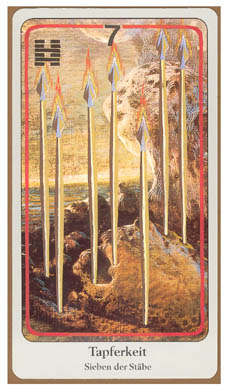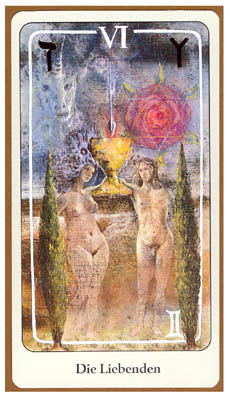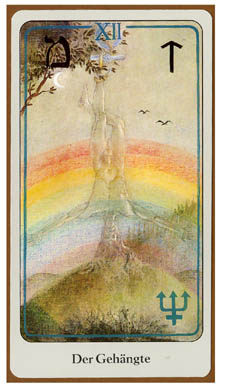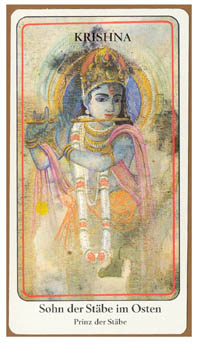|
 The Haindl Tarot is by the well-known German painter and scenograf, Hermann Haindl (born 1928). The Haindl
Tarot is not an occult tarot deck in the sense as f.i. Crowley/Frieda Harris' Thoth Tarot, (even if it has
many references to the Hebrew alphabet, the runes, the astrological planets and signs and to the I-Ching).
The Haindl tarot is rather - inspired as it is by prehistoric statues, temples and even by Wagner operas -
as Rachel Pollack states, a holy tarot, reaching back into the spiritual traditions of many cultures.
The Haindl tarot is not only based upon Eurasian nations, but includes references to Indian, Chinese and
Egyptian people. In her huge book describing the Haindl-tarot, Rachel Pollack states, that the main theme
of the deck is the revival of the Earth, not only of the material resources of the earth, but also the
spiritual life. The Haindl family stayed for a period with a North-American Indian tribe, and the
participation in their rituals has been a main factor in the creation of this deck.
The Haindl Tarot is by the well-known German painter and scenograf, Hermann Haindl (born 1928). The Haindl
Tarot is not an occult tarot deck in the sense as f.i. Crowley/Frieda Harris' Thoth Tarot, (even if it has
many references to the Hebrew alphabet, the runes, the astrological planets and signs and to the I-Ching).
The Haindl tarot is rather - inspired as it is by prehistoric statues, temples and even by Wagner operas -
as Rachel Pollack states, a holy tarot, reaching back into the spiritual traditions of many cultures.
The Haindl tarot is not only based upon Eurasian nations, but includes references to Indian, Chinese and
Egyptian people. In her huge book describing the Haindl-tarot, Rachel Pollack states, that the main theme
of the deck is the revival of the Earth, not only of the material resources of the earth, but also the
spiritual life. The Haindl family stayed for a period with a North-American Indian tribe, and the
participation in their rituals has been a main factor in the creation of this deck.
While it is not unusual to find references to the Hebrew alphabet in tarot decks, it is not so often that
we find the references Haindl uses to runes and to I-Ching. In his search to combine several traditions into
his universal tarot deck, he turns to runes as a Germanic tradition with roots of his own people. The runic
alphabet, with its variants according to age and country, does have one thing in common with the Hebrew
alphabet: the single letter is not just a letter, but has a deeper meaning. Originally this meaning derived
from the pictorial content of the letter, but later a further symbolic content developed. While runes
perhaps had their main function as an alphabet, the deeper magical meanings made them evident as a tool
for divination, protection and for amulets to bring good luck. According to Norse mythology, the runes
were given to mankind by Odin, who learned them by hanging nine days and nine nights at Ygdrasil, the
World Tree. Odin offered himself to the deep waters beneath the tree and emerged with the runes. The runes
being integrated in the Haindl tarot makes The Hanged Man, depicting Odin hanging from the World Tree, a
major card. (The motive of Odin can be found again in the "Father of Cups in the North", one of the
court cards). Haindl turned The Hanged Man into a card representing the element of water. Odin is
surrounded by the rainbow, the planet sign is Neptune, the Hebrew sign is MEM, which is "ocean", and
the element is water. From the different futharks (runic alphabets) available, Haindl has chosen to base
his references on the 18-letter futhark, which is an esoteric invention, made by Guido von Liszt in
Austria at the beginning of the 20th Century, and based on the text of HAVAMAL in the Edda. Von Liszt's
writings were unfortunately adopted by the strong pan-Germanic organizations and combined with their
overemphasized national and racist ideas. By using the runes in his tarot deck Haindl hopefully helps
to clear them from this discredit, their use by the Nazis put upon them. (Rumors have reached me, that
Haindl is continuing his work with runes, and works on a runic deck in collaboration with Nigel Pennick).
Hopefully this will be THE runic deck!
 The Haindl tarot contains three clearly distinctive parts: the major arcana, the number cards and the court
cards. While the contents of the major arcana came into being during the creative process, the number cards
were created in a more intellectual or, should I say, systematic way. Haindl decided - based on the tarot
tradition - what the theme for each card should be, and titled it according to that. Then he found in his
earlier works a painting or part of a painting that fitted into this theme, and which could serve as the
background for the card proper. To this he added the suitmarks.
The Haindl tarot contains three clearly distinctive parts: the major arcana, the number cards and the court
cards. While the contents of the major arcana came into being during the creative process, the number cards
were created in a more intellectual or, should I say, systematic way. Haindl decided - based on the tarot
tradition - what the theme for each card should be, and titled it according to that. Then he found in his
earlier works a painting or part of a painting that fitted into this theme, and which could serve as the
background for the card proper. To this he added the suitmarks.
The suits in the minor arcana of the Haindl-tarot are wands, cups, swords and stones, placed on backgrounds,
which do not show people, but rocks, ruins, water, plants or animals... "our kind of nature". Like the runes
in the major arcana, Haindl gave the number cards (2 to 10) references to the old esoteric oracle - or
model of the world - I-Ching by attributing a hexagram to each card. To find the right hexagram for the
36 number cards Haindl has, according to Rachel Pollack, used a subjective method based partly upon the
modern translation of the I-Ching by R.L.Wing and partly upon Richard Wilhelm's traditional translation.
Haindl "simply" found a text, which he felt was in accordance with the content of the card.
 Designing the court cards for his tarot, Haindl turned to the cultures of the world. Haindl calls
the four court cards: Mother, Father, Son and Daughter respectively, to obtain equal representation of gender.
The four suits represent the four directions. The North (and the European culture), is represented by the
suit of cups, referring to the Holy Grail, which is entirely a European symbol. The courts in this
suit are Venus from Willendorf, Odin, the Irish Brigid and Parcifal. The West (suit of stones), representing
the element of earth, a central theme in American Indian symbology, shows Spider Woman, Old Man, White
Buffalo and Chief Seattle. The East or India is for Haindl connected with the fire-element and the suit of
wands, and he has chosen to let Kali, Brahma, Radha and Krishna from the Hinduistic myths inspire the court
cards in that suit. The South or air is represented by the swords suit and deals with Egypt, which for years
has inspired tarot in many ways. Here we find Nut, Ra, Isis and Osiris.
Designing the court cards for his tarot, Haindl turned to the cultures of the world. Haindl calls
the four court cards: Mother, Father, Son and Daughter respectively, to obtain equal representation of gender.
The four suits represent the four directions. The North (and the European culture), is represented by the
suit of cups, referring to the Holy Grail, which is entirely a European symbol. The courts in this
suit are Venus from Willendorf, Odin, the Irish Brigid and Parcifal. The West (suit of stones), representing
the element of earth, a central theme in American Indian symbology, shows Spider Woman, Old Man, White
Buffalo and Chief Seattle. The East or India is for Haindl connected with the fire-element and the suit of
wands, and he has chosen to let Kali, Brahma, Radha and Krishna from the Hinduistic myths inspire the court
cards in that suit. The South or air is represented by the swords suit and deals with Egypt, which for years
has inspired tarot in many ways. Here we find Nut, Ra, Isis and Osiris.
 The Haindl Tarot is a most interesting deck, even in these years, where a new tarot appears practically
every week. The Haindl Tarot is artistically executed, it has a deep foundation in the tarot tradition,
and yet it is a quite different deck. The Haindl-deck adds a lot to the culture of tarot. It's artwork
is excellent, and the symbolic paintings have many layers that unfold during the use of it. Highly
recommended.
The Haindl Tarot is a most interesting deck, even in these years, where a new tarot appears practically
every week. The Haindl Tarot is artistically executed, it has a deep foundation in the tarot tradition,
and yet it is a quite different deck. The Haindl-deck adds a lot to the culture of tarot. It's artwork
is excellent, and the symbolic paintings have many layers that unfold during the use of it. Highly
recommended.
Rachel Pollack has written an excellent book to accompany the deck "Der Haindl Tarot - 78 Symbole der
Wandlung". Not a booklet to go with it, but a 510 page (!) large book, illustrating and describing the
deck and its symbology in detail. Rachel Pollack has worked with Hermann Haindl for a long time, has
discussed his works and registered his ideas. This book is not like most tarot books; it is a work, which
describes the creation of a work of art, its intentions and ideas, the story of how it came into being.
The book is written in English (and later published in that Language). The illustrations in the book are
B&W: you need the deck proper to judge the artwork.
|